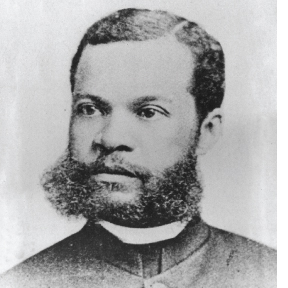Archdeacon Henry L. Phillips
Ninth Rector (1912-1914)...

Henry L. Phillips was born in Jamaica in 1847. He moved to New York City and was a lay reader at St. Philip’s Church before enrolling in the Philadelphia Divinity School in 1872. As a seminarian Henry Phillips thought that he benefitted by “the differing but equally effective teaching styles of two professors - Daniel Raynes Goodwin, who encouraged wide-ranging discussion, and George Emlen Hare, who discouraged all questions during class time.” Rev. Phillips was ordained to the priesthood in the Episcopal Church in 1875 by the Bishop of Pennsylvania The Rt. Rev. William Bacon Stevens. Soon after his ordination Fr. Phillips had charge of St. Thomas for seventeen months. It is likely that he was the interim after the resignation of The Rev. William J. Alston. Fr. Phillips recalled that “he began his first service at [St. Thomas] promptly at 10.30 am, only to be told by the organist afterwards that he should have waited until she played a voluntary when there were enough people in the congregation for the service to start.” Fr. Phillips said that “his … training could not accept [such a practice] and the congregation happily accepted services that started on time thereafter.” The Rev. Henry Laird Phillips had a reputation for being “strong-willed.” It seems he was that way even as a young priest.
The same year that he had charge of St. Thomas Fr. Phillips married Sarah “Sallie” Elizabeth Cole the daughter of an old distinguished St. Thomas family. Supposedly, Rev. Phillips first spied Sallie as she sang on St. Thomas’ choir. Sallie Phillips had three influential sisters. One sister was Mrs. Andrew Stevens - wife of one of the eras most successful caterers. A second sister Dora Cole was an educator who later became one of Philadelphia’s public school principals. Dora, together with pioneer black school principals Jacob C. White, Jr. and her fellow St. Thomas member and civil rights veteran Caroline R. Le Count (fiancé of the martyred Octavius Catto), and St. Thomas lawyer John Stephen Durham, and her sister Rebecca, fought discrimination against black teachers but eventually Dora left the field of education and secured a job as a civil servant in the government pension office. The third sister, Rebecca Cole, was a pioneer black female physician and held the distinction of being the first black graduate of the Women’s Medical College. Dr. Cole struggled to maintain a practice but she worked with Fanny Jackson Coppin to incorporate courses on physiology, preventative medicine, and hygiene into the curriculum of the Institute for Colored Youth. Sallie Phillips was known as a “church worker in the largest sense.” She was “beloved of the old and helpless, efficient in details and rummage sales, foremost in guilds and classes, and the genius of the embroidery class.” It was said that “As wife, mother, church worker and friend Sarah Elizabeth Phillips belonged to the elect.”
In 1903, Dr. Du Bois was at Atlanta University and had just completed his influential report on the Negro Church. In it he referred to Fr. Phillips saying “… the Negro priest of longest service in the Episcopal Church is one of the most valuable social reformers of the day, the Rev. H[enry] L[aird] Phillips of Philadelphia.” After leaving his interim role at St. Thomas Fr. Phillips became the rector of the Church of the Crucifixion where he organized a Coal Club, a Free Ice Fund, a Home for the Homeless, and a Penitentiary Service that reached out to Moyamensing Jail and Eastern State Penitentiary. Rev. Matthew Anderson, Oberlin College graduate and pastor of Berean Presbyterian Church, had founded Berean Manual Industrial Training School. Fr. Phillips served as secretary of the school’s board. Fr. Phillips also served on the city’s Vice Commission and historian Roger Lane asserts that he “was the most extreme local spokesman for the forces of respectability [advocating for] forced labor for petty thieves and gamblers” and the “whipping post” for men who forced women into prostitution. Fr. Phillips called for Christian outreach to black southern migrants because of concerns about their so-called proclivity for criminal behavior writing that “We need such Christian activities especially because of the class of colored people we are continually receiving from the South.” Another historian, Khalil Gibran Muhammad cites this attitude as an example of “obfuscat[ing] the reality of structural barriers and racist sentiments” that impacted the assimilation of these migrants. Simultaneously, Fr. Phillips supported Ida B. Wells’ antilynching campaign. In 1919 when his fair-skinned brother-in-law Andrew Stevens bought racially-restricted property and transferred it to a darker skinned member of St. Thomas’ Cowdery family some incensed white Philadelphians started a race riot. Fr. Phillips advocated for black Philadelphians to use arms in self-defense. Perhaps it should not be surprising that given the “force of nature” that was The Rev. Henry Laird Phillips his tenure as the ninth rector of St. Thomas (1912-1914) was so short.
He began his ministry at the Crucifixion Mission on South 8th Street. It became one of the leading churches in the nation for its social programs, which included the creation of the first penny savings bank for Negroes in the United States; the expansion and growth of the Home for the Homeless, the only facility of its kind in the city for destitute women and children of both races and the first Philadelphia gymnasium for Blacks out of which grew the Christian Street YMCA. He was later appointed Archdeacon for Colored Work for the Episcopal Diocese of PA. He celebrated his 100th birthday in March 1947.